The simple Press Release issued by Buckingham Palace last summer, 1999, announcing the State Visit by Queen Margrethe of Denmark, suggested little of the major ceremony and organisation that lies behind an event such as a State Visit.
Preparations started months ago in a variety of offices and departments in Windsor and London to ensure that the visit would be a success and for several weeks the Ceremonial Route was being prepared with over 100 flags and flagpoles together with a pavilion in which the royal guests were greeted by HM The Queen and The Duke of Edinburgh. 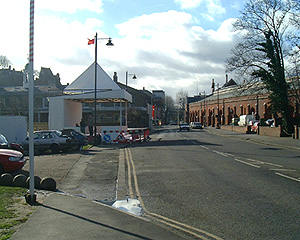 Reception Dais in Datchet Road, opposite Windsor Riverside Station. On Wednesday, 16th February 2000, roads in the town centre were closed from 12.30 in readiness for Queen Margrethe's arrival at 2.30pm with her husband Prince Consort Henrik. Queen Margrethe was greeted by the Queen and the Duke of Edinburgh at a specially constructed pavilion by the Windsor and Eton Riverside Station as a Royal Salute was fired by The King's Troop Royal Horse Artillery from the East Lawn of Windsor Castle. Following introductions to Philip Wroughton, Lord Lieutenant of Berkshire, Cllr. Sandra Hopkins, Mayor of Windsor, and others in the reception party, the Royal party boarded three magnificent coaches and processed to the Castle, escorted by the Household Cavalry and The Blues and Royals. Passing up Thames Street, around the Curfew Tower, along the High Street and Park Street, to enter the Castle from The Long Walk by Cambridge Gate. During her visit, Queen Margrethe will visit a local school, Lea Infant School, Slough and view the Millennium Dome, among other engagements. 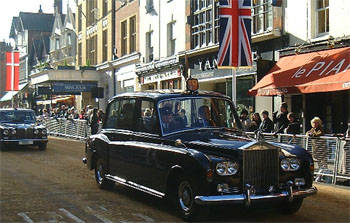 on their way down to Datchet Road to meet Queen Margrethe As crowds gathered along the route, the bells rang out from The Curfew Tower and a few moments later the procession approached the Castle from Datchet Road. Fist came two mounted police, then two officers of the Household Cavalry followed by a third, with nervous glances backwards as they paused at the junction with Thames Street to check that the rest of the procession was indeed following along behind. There must have been a momentary hitch of some sort as this leading group had to wait for the others to catch up! 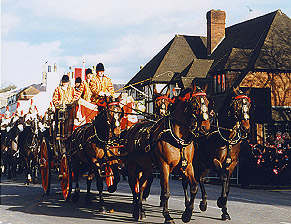 But almost immediately all was well and the grand spectacle of the Horse Guards in full ceremonial dress passed by, followed by the first of three State Carriages in which rode Queen Elizabeth and Queen Margrethe. The second carriage carried the Duke of Edinburgh with Prince Henrik followed by a third in which rode the Duke and Duchess of Gloucester with Lord Vesty, Master of the Horse, and The Danish Minister for Foreign Affairs, Mr Niels Helveg Petersen. 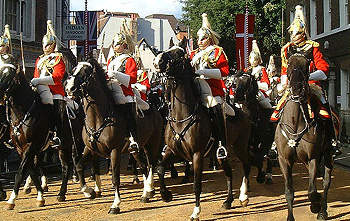 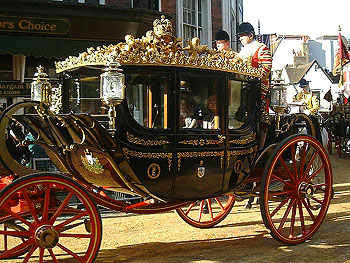 accompanied by the Queen The Australian State Coach was a gift from the Australian People in 1988. Not all the State Coaches are from a bygone age! 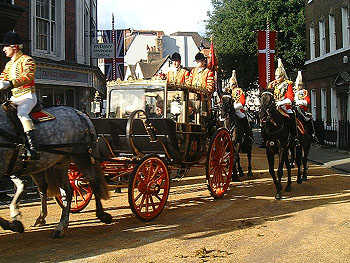 The Scottish State Coach 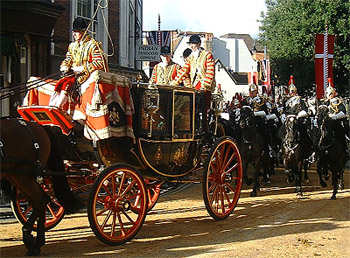 Lord Vesty, Master of the Horse, and The Danish Minister for Foreign Affairs, Mr Niels Helveg Petersen. The Blues and Royals bring up the rear. 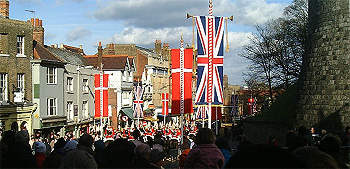 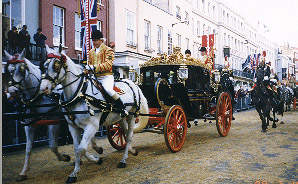 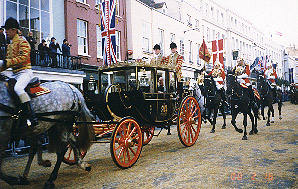 in the High Street. Most of the photographs above were taken by a Fuji Digital camera and were included on The Royal Windsor Web Site shortly after the procession had passed by. Windsor is second only to London in importance for State events such as these and will host many more in the coming years. The Royal Windsor Web Site will cover all such events and provide a permanent record together with increasing references to the background of such events.
|